Over 80 percent of local funding for Southwest LRT in place
Plan for securing remaining local funds by June 2016
The Metropolitan Council is working with the state and project partners on transportation funding in the 2016 legislative session for the remaining $135 million state share of the cost to build the proposed Southwest LRT line.
The Council made significant progress on the project in 2015. Early in the year, President Obama recommended the project for a Full Funding Grant Agreement in his 2016 budget. Strong local support was shown throughout the municipal consent process that ended in September. Project design was 60 percent complete in fall 2015. Met Council submitted its notice to the Federal Transit Administration regarding its intent to apply for entry into Engineering in mid-2016.
While President Obama has recommended federal funding for the project, the federal government will only make its funding commitment real once all the local funding is formally committed. Absent the full $135 million funding appropriation in the 2016 legislative session, Southwest LRT would fall to the back of the federal funding queue for New Starts projects. This would delay the project and cost an additional $50 million for each year of delay.
Recently, the U.S. Congress included $5 million for the Green Line LRT Extension as part of its 2016 omnibus appropriation, demonstrating its support for the project moving forward to a Full Funding Grant Agreement. The bill was signed into law by President Obama on Dec. 18.
The project would finalize cost estimates and complete the environmental process in summer 2016 prior to entry into Engineering. The Met Council also would receive price proposals in the same timeframe for significant contracts, including civil construction and light rail vehicles.
Site preparation work to begin
Site work would begin in the fall, after receipt of the environmental Record of Decision, to prepare for the start of heavy construction in 2017.
Site prep work would include relocating underground utilities, clearing trees and plants and moving freight rail track to make room to accommodate both LRT and freight rail tracks.
Construction supervisors would be hired and a construction office established.
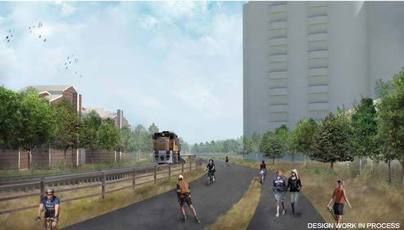 Images show how landscape would change with addition of LRT
A series of new images created by Southwest LRT design and engineering staff shows how the proposed new LRT line and stations would be integrated into the surrounding landscape.
Above: A freight train travels through the Kenilworth Corridor next to pedestrian/bicycle trails in this rendering created by Southwest LRT Project staff. LRT tracks are in a tunnel beneath the trails.
Combining photography with illustrations based on engineers’ designs, the renderings show views from a variety of key points along the route of the Green Line Extension, including trails, station areas and LRT tracks.
A selection of design renderings is shown below, along with photographs of existing conditions. All images represent work in process.
|
Eden Prairie
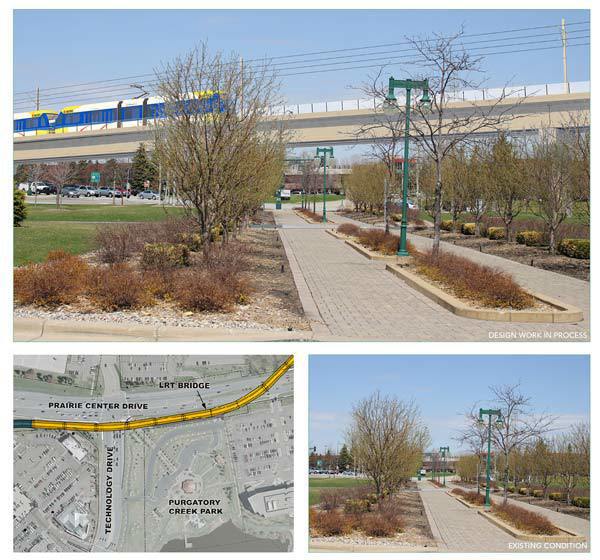 A new bridge would carry light rail vehicles near the Purgatory Creek Park pavilion in Eden Prairie (large image). Top view is looking northeast toward Prairie Center Drive.
Minnetonka
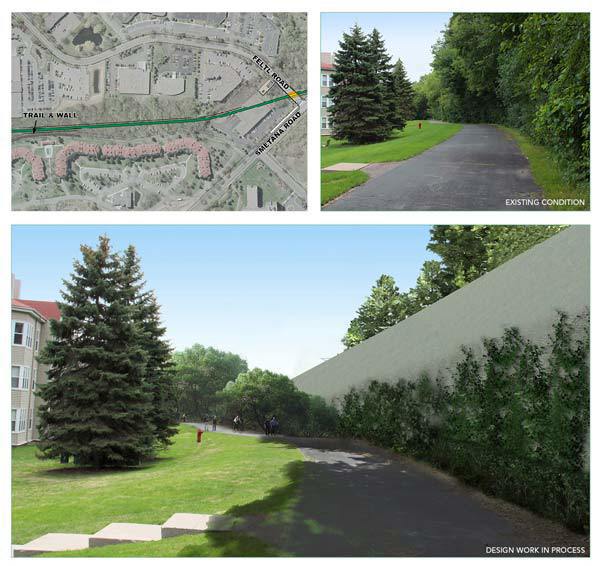 A retaining wall would be constructed along the slope west of the Claremont Apartments in Minnetonka (large image, bottom). The existing trail would be preserved.
Hopkins
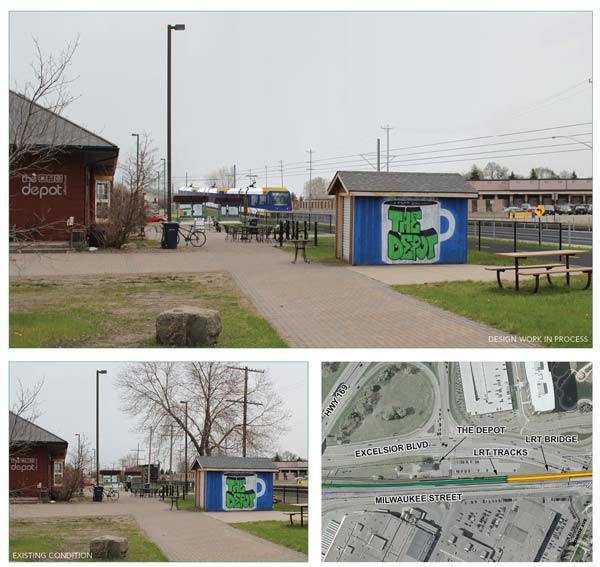 The Depot is a popular local meeting place south of Excelsior Boulevard in Hopkins. The existing outdoor patio and outbuilding would remain next to the LRT tracks.
St. Louis Park
 A trail along existing freight rail tracks in St. Louis Park would be reconfigured with the addition of LRT. This view is at Brunswick Ave., looking west toward Jorvig Park.
Minneapolis
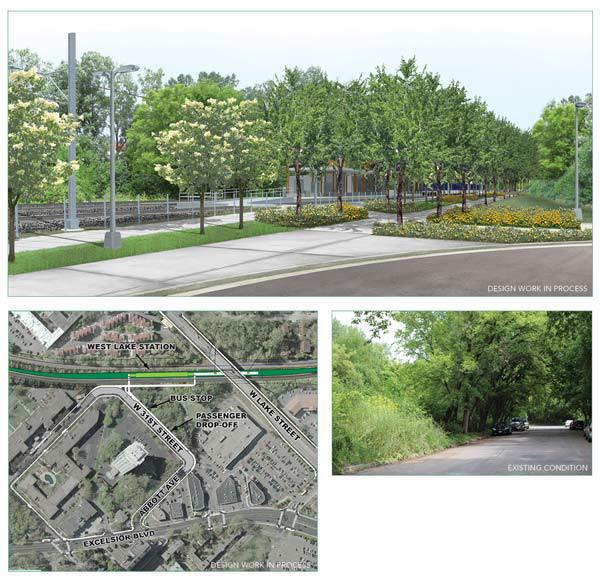 At West Lake Station in Minneapolis, Abbott Ave. and West 31st Street would be reconfigured to create a passenger drop-off area and an enhanced bus connection (overhead view).
Landscaping around the proposed station area (large image) includes tree planting and pedestrian amenities.
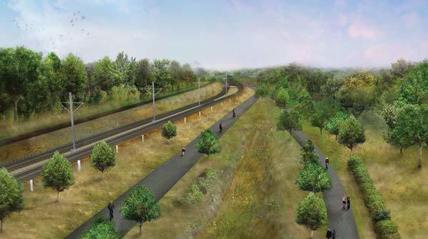 Kenilworth landscape plan gets support at community meeting
Reflecting prairie, meadow, wooded and narrow landscapes is the vision designers have for landscaping the Kenilworth corridor when the proposed Southwest LRT line is built.
Above: View of planned landscaping southwest of the proposed 21st Street Station, looking north.
After meeting since May with a committee of residents, landscape designers hired by the Southwest LRT Project presented renderings in November of their plans for how the corridor would look in the future.
The renderings show native plants, seating made out of trees to be removed from the corridor, and viewing areas at the tunnel openings. Designers incorporated these features as a result of public feedback from advisory committee meetings, pop-up events, and three community workshops since the spring. For workshop details, visit:
http://bit.ly/1lt0wVV
The project would keep about 200 of the existing trees in the corridor and add approximately 480 trees. Specific types and numbers of trees and plants to be added are still to be determined as the design progresses. A final tree report published in 2014 showed 1,960 trees of 6 inches in diameter at chest height and greater in the 44-acre study area. The study by a certified tree inspector found 480 trees significant trees, which city code defines as those that are a foot or greater in diameter at chest height. About 80 percent of these were native softwoods, such as cottonwood, elm and boxelder. Very few hardwoods were present.
Designs for the north and south portals of the proposed LRT tunnel feature pedestrian-friendly landscaping and seating elements where trail users can view trains entering and leaving the tunnel.
|
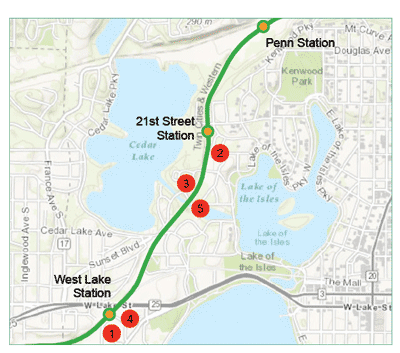 |
|
Approximate locations of views:
1. West Lake Station area
2. Landscaping southwest of 21st Street Station
3. North LRT tunnel portal
4. South LRT tunnel portal
5. Kenilworth Channel crossing.
|
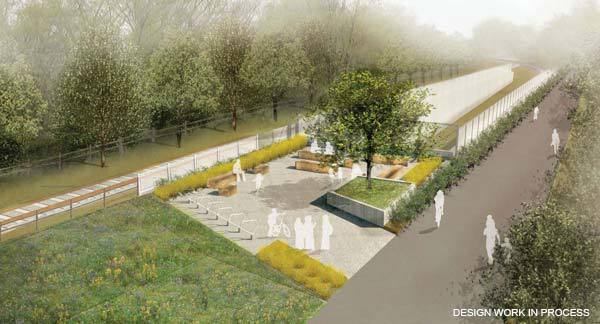 The proposed north LRT tunnel portal, between the Kenilworth Channel and 21st Street Station, with seating area and bicycle parking.
 The proposed south LRT tunnel portal, near the meeting of the Kenilworth Trail and the Midtown Greenway.
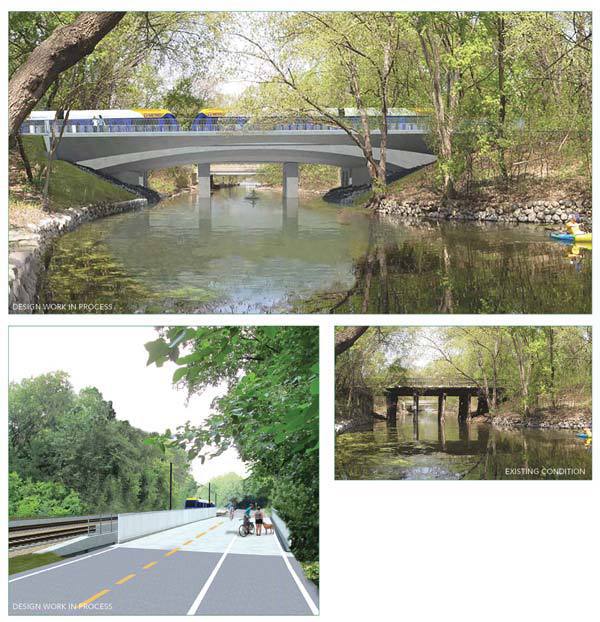 The proposed LRT and trail bridge over the Kenilworth Channel (large image) would replace an existing timber structure. The image at lower left shows the new trail bridge over the channel.
 Nearly 200 contractors show interest in bidding for proposed Southwest LRT line
|
Above: Attendees at the Oct. 21 event listen to a presentation on the Metropolitan Council’s contracting procedures.
Construction contractors from around the country gathered in Minnetonka on Oct. 21 to learn about the planned Southwest Light Rail Transit line, the largest public works project in the state’s history, and network with firms that are likely to bid on the project.
Nearly 200 people attended the “Contractor Mixer,” which included a presentation on the construction plans for the proposed 14.5-mile METRO Green Line Extension from downtown Minneapolis to Eden Prairie. While heavy construction would not begin until 2017, potential contractors need time to prepare their bids for an anticipated spring 2016 deadline.
The mixer “was probably the best we’ve been to,” said Johnny Cross, proposal coordinator for Herzog Contracting Corp., a St. Joseph, Mo.-based construction firm. “We got over 100 different contacts of minority and women-owned businesses. I started handing off business cards to (Herzog) people who were with me because my pocket was so thick with cards.”
Attendees heard first from Adam Duininck, the chair of the Metropolitan Council, which is leading the planning efforts for the Green Line Extension. The project anticipates a need for 7,500 workers during construction from 2017-2019, and Duininck said he was pleased with the turnout for the mixer. In comparison, construction of the Green Line employed 5,500 workers from more than 60 Minnesota counties and had a construction payroll of $256 million.
The Green Line Extension project will have three contracts for heavy construction. They will be for civil construction, construction of an operations and maintenance facility in Hopkins, and the electrical systems that will power the light-rail vehicles, control signals and provide communications.
The civil construction contract will include 35 track miles (29 miles for the double-tracked 14.5-mile LRT line and six miles of freight track), roadways and trails, 15 stations, underground infrastructure for an eventual 16th station and park-and-ride sites near some of the stations. The project also involves construction of 3.5 miles of bridge structures, over a half mile of tunnels (two), utility work and relocations, and 6.5 lineal miles of retaining walls.
“We’re going to need probably every pile driver in the United States,” Kevin Ryan, the project’s construction manager, told the crowd. While Ryan was joking, the project will have 69 miles of retaining wall foundation piles.
The 172,000-square foot operations and maintenance facility in Hopkins will service up to 30 light-rail vehicles and provide space for cleaning and storing them. About 150 employees, including the train operators who will start and end their work-day at the facility, will report for work at the site, which will be a half mile from Excelsior Boulevard.
The systems contractor will be responsible for building and installing 20 traction power substations, which are about the size of intermodal train containers. The substations will convert alternating current from Xcel Energy lines to direct current to power the trains. The direct current will be carried by miles of overhead wire to be strung by the contractor from more than 1,000 catenary poles that the contractor will also install. The systems contractor also will build and install 25 signal bungalows or houses, which are about the size of telephone booths, to control 15 at-grade crossings.
When the project assembles the bid packages, the Metropolitan Council will set overall Disadvantaged Business Enterprise (DBEs) goals for the prime contractors, who will hire DBE subcontractors to help meet the goals, said Andrew Larson, an equal opportunity consultant with the Metropolitan Council. DBEs are small businesses owned by minorities or women that meet federal criteria by ownership and size and are certified as such.
For the individual construction workers employed by the contractors on the Green Line Extension, the Metropolitan Council will follow the state-established workforce participation goals for projects in Hennepin County, which is 32 percent minority and 6 percent female.
Attendees were able to network after the presentation around tables staffed by representatives of large contracting firms and organizations representing minority and women-owned businesses.
Barb Lau, the executive director of the Association of Women Contractors, said the turnout at the mixer was strong at the table the organization staffed.
“I was amazed,” she said. “I didn’t expect it to be as busy as it was.” The association she heads assists businesses that are looking for work as subcontractors on construction projects. The association also works with government agencies during construction to make sure the inclusion rate for women-owned businesses is occurring at the targeted rate.
Passenger revenue service is anticipated to start in 2020.
Owners of DBEs interested in learning more about the project should contact Larson at andrew.larson@metrotransit.org and prime contractors should contact Kevin Ryan at kevin.ryan@metrotransit.org
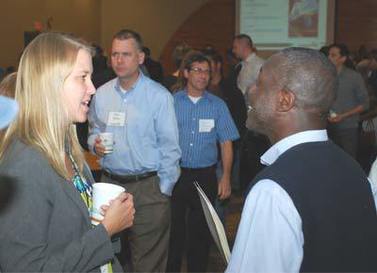 |
|
Christine Beckwith (left), deputy director of the Metropolitan Council’s light rail transit development program, discusses contracting opportunities with Hector Bruce of Minneapolis-based Thor Construction.
|
About the Project:
The planned Southwest Light Rail Transit (LRT) Project (METRO Green Line Extension) will operate from downtown Minneapolis through the communities of St. Louis Park, Hopkins, Minnetonka, and Eden Prairie, passing in close proximity to the city of Edina. The line will connect major activity centers in the region including downtown Minneapolis, Methodist Hospital in St. Louis Park, downtown Hopkins and the Opus/Golden Triangle employment area in Minnetonka and Eden Prairie. Ridership in 2040 is forecasted at approximately 34,000 average weekday boardings. The project will interline with the METRO Green Line, which will provide a one-seat ride to destinations such as the University of Minnesota, state Capitol and downtown St. Paul. It will be part of an integrated system of transitways, including connections to the METRO Blue Line, the proposed METRO Blue Line Extension, the Northstar Commuter Rail line, a variety of major bus routes along the alignment, and proposed future transitway and rail lines. The Metropolitan Council will be the grantee of federal funds. The regional government agency is charged with building the line in partnership with the Minnesota Department of Transportation. The Southwest Corridor Management Committee, which includes commissioners from Hennepin County and the mayors of Minneapolis, St. Louis Park, Edina, Hopkins, Minnetonka, and Eden Prairie, provides advice and oversight. Funding is provided by the Federal Transit Administration, Counties Transit Improvement Board (CTIB), state of Minnesota and Hennepin County Regional Railroad Authority (HCRRA) and other project partners. The Southwest LRT Project website is www.swlrt.org
|